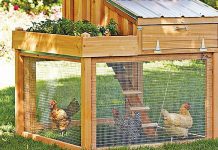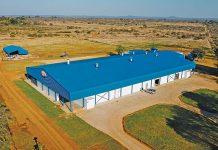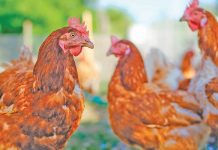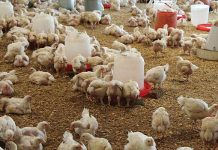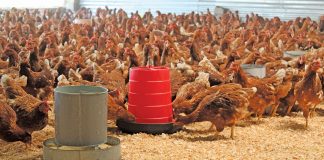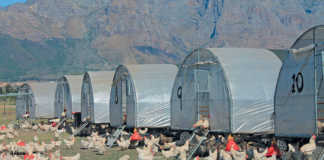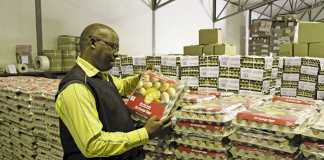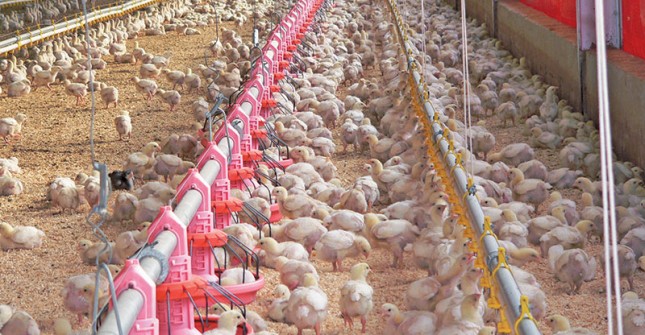
The conditions under which chickens are housed – including heating, ventilation, air quality, water availability and feed – have a direct impact on the profitability of a poultry farming business.
Sonét Roux, technical advisor at Country Bird Holdings, says that managing broiler chickens can be challenging for producers, especially in winter, as they have to find a balance between heating the air inside the house and ventilating for desirable air quality.
However, it is not only in winter that ventilation and heating are important. Farmers have to monitor them throughout the year to ensure that the birds are always comfortable. “For every second your chicks are not comfortable, money is leaving your pocket,” Roux stresses. The reason, she explains, is that the birds will not grow at the optimal rate.
Comfort during brooding period
The majority of farmers who run smaller poultry operations that are not yet commercial, use curtain houses. These are open on the sides with curtains regulating the internal temperature. It can be more difficult to control internal temperatures and ventilation in this type of housing, but it is possible with good management, says Roux.
Drawing on her own experience of using curtain housing for many years, she explains: “You can run curtain houses successfully, but the trick is to be [based] on the farm. Remember, the chicken house, regardless of how technically advanced it is, will not raise the chickens for you.” Always keep a close eye on small chicks to ensure that they are active, she advises.
“Farmers who find their chicks are inactive shortly after placement because of cold temperatures must walk among them to keep them active,” she says.
Producers should take extra care to stabilise the temperature before placing chicks; a chicken house that is too cold will cause young birds to lose heat rapidly. Consistent heating during the brooding period – the first 14 days of a broiler’s life – is essential to achieve uniform growth. During this time, birds are transitioning to a mature thermoregulation system.
“Some producers think that by week two they can stop heating, but this is incorrect, as a lack of heat could lead to great losses. Day-old chicks need heating even on a hot day,” Roux says.
Warmth is critical to the wellbeing of young chicks, but their need for artificial heat decreases as they get older. As a general rule, day-old chicks need a temperature of 34°C; thereafter, 0,3°C should be deducted daily. “It’s always important to see how chicks behave and then adjust temperatures accordingly,” Roux says.
Farmers with small operations should monitor the temperature with a thermometer placed above the birds, at about knee height, to obtain an accurate reading. For small chicks, temperature can be managed by reducing the size of the brooding area with a curtain barrier, but numbers should not exceed 45 chicks/m2.
Chick paper, which enables young birds to drink and feed more easily, also improves insulation in chicken houses, and provides young birds with a warmer floor covering. Roux recommends the use of chick paper if a farmer is struggling to maintain consistent floor temperatures in a curtain house.
The paper should be rolled out under the drinking lines and the feed placed on top. When chicks walk on the paper, it makes a rustling sound; this attracts other chicks to the feeding and drinking area. The paper breaks down after three to five days, making it unnecessary to remove the sheets once used.
The paper is highly absorbent and soaks up water and droppings, helping to keep moisture off the floor and away from the birds.
Cost-effective heating
Achieving precision in heating is essential to ensure that rising costs, such as electricity, do not erode the farmer’s bottom line. “As electricity prices rise, the cost of heating a poultry house will become a major factor in raising broiler chickens,” Roux says.
Gas heating units, known as gas brooders, are effective and reliable heating devices that can help farmers reduce their electricity bills. She advises farmers not to rely solely on electricity, as power failures could result in significant financial losses.
Gas brooders also have a thermostat that makes it possible to regulate temperature automatically. As the temperature increases, the gas heater switches to a lower setting, which increases again as the temperature falls.
However, Roux says that installing brooders would not be cost-effective for farmers who are not running large commercial operations due to the significant capital outlay. If the chicken house is too cold, hot or wet, chickens will struggle to achieve the correct feed conversion ratio, as there is a relationship between body temperature and weight gain.
“Feed is the most expensive part of your business, and if birds cannot utilise it properly they won’t gain enough weight, she says.
According to research at the College of Agriculture, Food and Environment at the University of Kentucky in the US, natural ventilation has proved to be a popular technique. It is low-cost and requires less maintenance, but it is also more challenging to control if there are external changes in wind speed and direction, as well as the outside temperature.
Farmers have to ensure that naturally ventilated buildings have enough side and ridge openings for fresh air to be distributed evenly throughout the building. Roux says that producers tend to reduce ventilation rates during the winter season to save on production costs such as heating, but this can cause a decline in chickens’ productivity.
READ Chicken housing – get the basics right!
Warm air holds more moisture, which results in the bedding getting wet more often. A combination of heating and ventilation, which uses cold and dry air from outside, will remove considerable levels of moisture from the house.
She says that farmers will know if they are under-ventilating, as the quality of the bedding will deteriorate. It is also important to be aware of over-ventilation, as this creates draughts and increases exposure to wind chill.
Producers sometimes become concerned during summer when there is extreme heat.
They “go into full tunnel ventilation [when the birds are at] a young age”, says Roux. But this is unnecessary, as birds cope better with slightly more heat than draughty conditions. A well-constructed and insulated chicken house can contribute significantly to effective heating, as well as the amount of supplemental heat needed, and the ventilation required.
Farmers with curtain houses should also be aware of draughts coming in from under the curtains. Fortunately, explains Roux, chickens will indicate when they are uncomfortable.
When they huddle together, the temperature is too low; when they move to the sides of the house, the temperature is too high or they lack oxygen.
“Don’t be afraid to use more heat to keep chicks warm and comfortable because you will always recoup your cost with good chicken weights,” she says.
Phone Sonét Roux at Country Bird Holdings on 011 447 6044.



